
As with all of our reviews, we like to actually use the product and spend time with it before giving the thumbs up (or down). When Black & Decker asked us to try out their new Rapid Roller, I was happy to accept. Unfortunately I didn’t have any painting projects lined up, and I haven’t really been looking for them either. Can you guess that painting is not one of my favorite things? Well after weeks of dirty looks from the Rapid Roller, I used it for a project, and I really liked it. The Rapid Roller paints just fine, but that’s not what sold me. You’ll have to read on to find out why.
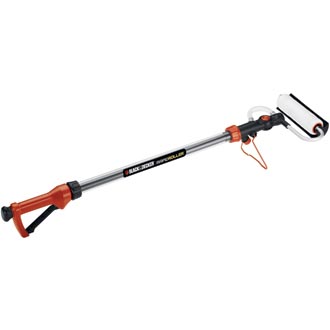
You Only Get One First Impression
Out of the box, the Rapid Roller is almost ready to use. There are a few pieces you need to connect, and if you read the manual, you’ll learn they suggest dabbing some petroleum jelly (included) to lubricate a few places. The Rapid Roller is similar to other products like the PaintStick in that it comes with a cover that snaps over a gallon of paint, and you suction the paint into the handle. As you work, pulling the trigger pushes paint to the roller enabling you to work faster. Unlike competitors products Black & Decker included a few innovative ideas that set the Rapid Roller apart from the rest.
This is the roller head assembly out of the box. That’s the paint can fill tube in the upper right.
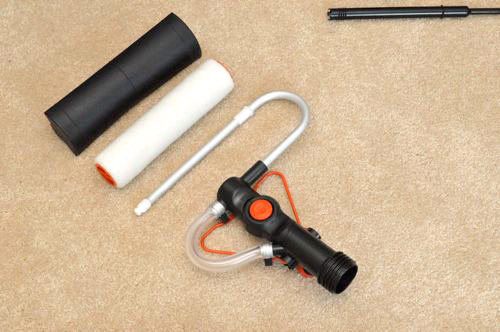

Here’s a picture of the fill nozzle.
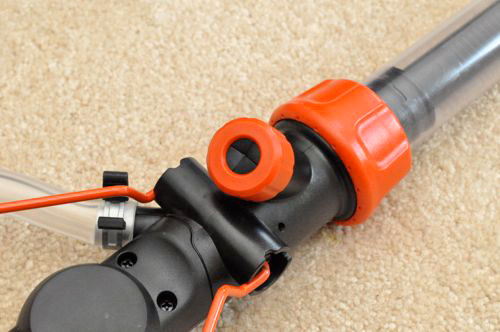
This is the flexible supply tube with hose clamps.
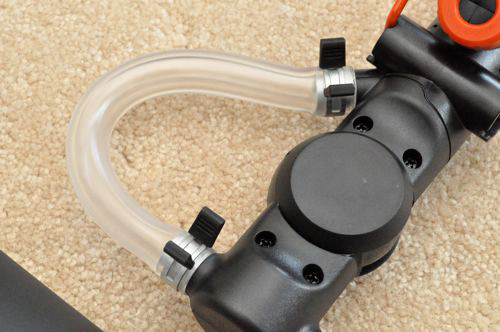
And here’s the ratcheting trigger that pumps more paint to the roller.

Kickstands- Not Just for Bikes
B&D added a nice little wire frame kickstand that keeps the roller up off the floor. When you need to take a break or grab another BEvERage, just flip the kickstand down and walk away. This is important because the only reason products like these enable you to work faster is by eliminating the paint tray. Without the paint tray, you need somewhere else to put the Rapid Roller and the kick stand solves that problem. The kickstand is nice, but that’s not what sold me on the Rapid Roller.
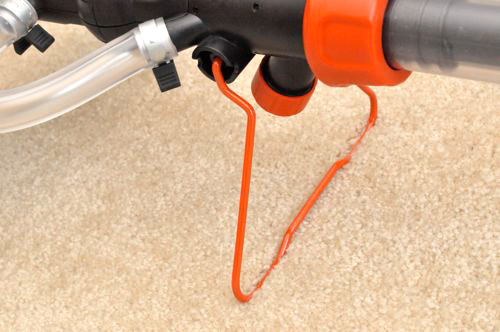
It Pivots Too
This is the first roller I’ve seen that pivots. By pressing the orange button on the roller head, you can rotate the angle between straight, 40° and 80°. I know it sounds gimmicky, and it’s not the sort of thing I’d use very often but it is handy when you’re painting those tough to reach corners. Again, this isn’t the feature that makes me want to recommend the Rapid Roller.
That orange button is the pivot lock.
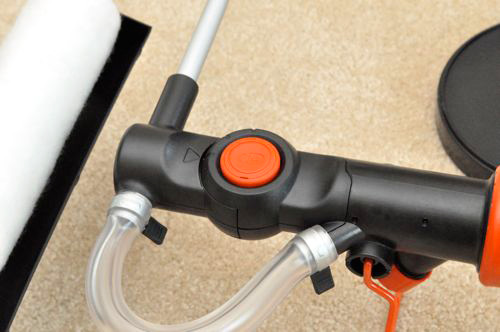
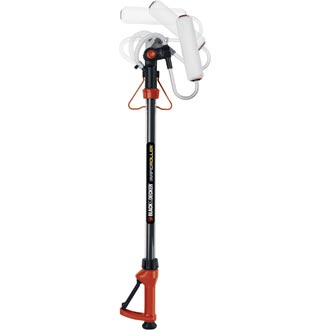
Cleanup
The reason I really liked the Rapid Roller is because it was easy to clean. If you’ve ever used a similar product, you know how tough it is get every last bit of paint out after you’re done. When you’re finished painting with the Rapid Roller, you push the excess paint back into the can through the fill nozzle. Next, the entire things disassembles. The plunger can be removed from the handle. The flexible tubing disconnects when you squeeze the hose clamps. The roller head and fill nozzle can come apart. While disassembling the entire thing can be time consuming, it ensures that you won’t sabotage your next paint project.
These pictures were taken after using the rapid roller (with dark red paint) and then cleaning it up.
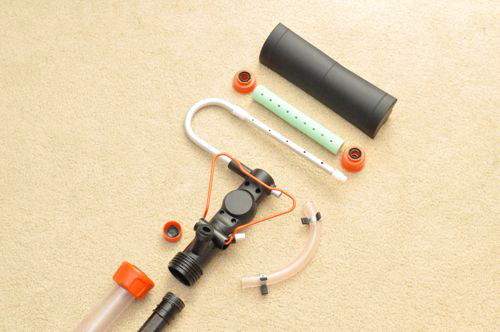
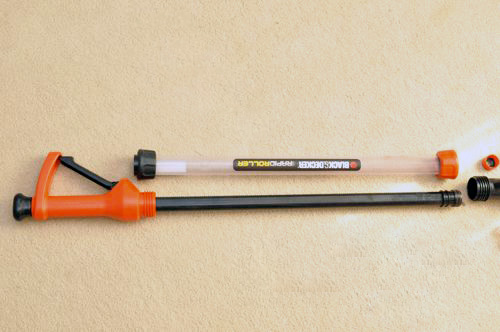
All together I really liked the Rapid Roller. I have no doubt that it makes painting faster, and it’s a good purchase for all you homeowners with a lot of paint projects coming up. As I said, the real benefit is how easy it cleans up. My only complaint, and it’s a small one, is that the flexible tubing could be eliminated if you ditch the pivoting head. I’d rather have fewer parts to clean and fewer parts that could potentially break. Make sure you buy perforated roller replacements, or you’ll have a fun mess to clean up. The Rapid Roller has an MSRP of $45 but you can find it on Amazon for about $30.
Do you have a Rapid Roller? What about a PaintStick? Are they worth the extra cleanup time?







I’ve used one of the paintsticks in the past. I used it both on my ceilings and walls in a previous house. The included splatter shield keeps down the mess, especially with doing the ceiling. The one I had required compressing the tube as you went and a trigger would have made it a bit easier not to mention keeping the length the same. Being “vertically challenged” the length of the stick came in handy especially when on top of a ladder which also gave me better control than a long pole from the floor with 11 foot ceilings. That, and not having to constantly reload the roller from a tray. A piece from my old one went missing in a move. So it’s time for a new one. I have lots of painting in the new house and I think this product will fit the bill. If anyone wants to send me one… 😉
Oo. This would have been awesome to use when I painted my ceiling and kitchen a few weeks ago. But then again I am cheap. My roller with a broom handle was free.
Any idea on spare parts? I fear that eventually I’d pull a “George” and lose a piece.
Hehe… I don’t know about spare parts. Let me check w/ B&D.
I have some painting projects on my list… That may be worth the $30 and make the job little less unpleasant!
Hey! There were 4 moves in between! 😉
Always wanted one of these ever since I seen an infomercial late at night many years ago. That one though was cheaply made. The one you have seems like a huge improvement.
I have the EZTwist PaintStick. A few thoughts:
1. It really makes painting a ton easier than with a traditional roller and tray. It is easier to apply a thicker coat of paint and requires less trips to refill. Of course it is faster to apply the coverage as a result.
2. It is a lot more effort to cleanup and you have to be extremely thorough with your cleanup. You do have to disassemble the entire thing and really get it cleaned out thoroughly. If you don’t do it properly you’ve most likely just reached the end of life of your roller and will have to replace it.
3. You need more room to work than a traditional roller. If you are painting a smaller area that doesn’t give you much room behind you (4ft+ is sufficient) then it becomes annoying to find the proper angles while applying the proper pressure. The tilting head on this one may help with that. Not sure though.
For someone who dislikes painting as much as I do, the benefit of speed, less refills, better reach for higher spots, and thicker coat easily outweigh the time spent to clean it thoroughly.
Your absolutely right about the cleanup and that’s why it doesn’t make sense to use it for smaller jobs- you lose all the time savings getting all the excess paint out. I don’t think the pivoting head really helps you work in smaller places. It just makes it easier to paint things like corners and along the ceiling.
Well, as you can see by my online name I really don’t mind painting. To me it’s rather therapeutic. So, I would forego the cost and effort of clean-up. (I don’t clean rollers- just pitch them when I’m done.)
Feel free to come on over. I’m mudding the drywall in our new workshop and it’ll need to be painted soon! You can paint to your hearts content 🙂
I wonder if you can get the lambs wool rollers that would fit something like this? My father-in-law turned me on to using the lambs wool rollers and they provide really nice coverage and clean up nicely.
Eight years ago when we had a whole house to prime and paint we bought two of the Wagner TurboRollers so our daughter and I could get busying painting everything. We were very happy with their performance. Since then I’ve not used them because like Carol/Paintergal, we toss the rollers once finished painting a room. Not very “Green” of us, but then again maybe it’s the greener thing to do since I’m not over using water to clean them, putting the VOCs back into our ground water, because the paint dries on the roller.